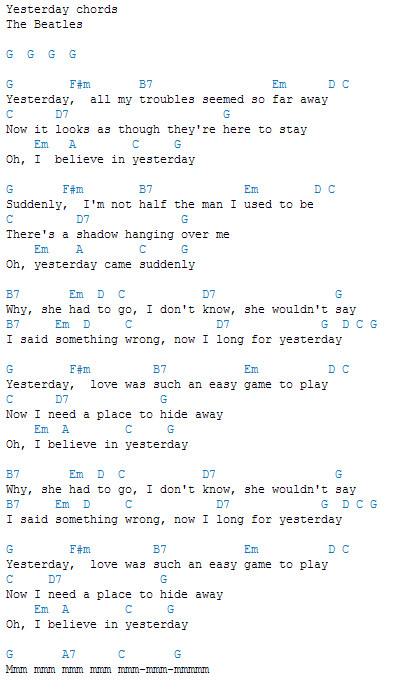“Yesterday,” a timeless masterpiece credited to Lennon-McCartney but solely penned by Paul McCartney, resonates deeply with music lovers across generations. Its enduring popularity is evident in over 2,000 cover versions, solidifying its place as one of the most covered songs in music history. For guitar players aspiring to master this classic, we offer a comprehensive guide featuring the full guitar tab for “Yesterday,” a simplified strumming version using chords and lyrics, and insights into the song’s composition.
Download the Complete “Yesterday” Guitar Tab
Unlock the intricate fingerstyle arrangement of “Yesterday” with our complete guitar tab. Click the link below to download the PDF and dive into McCartney’s acoustic genius.
Simple Strumming Version for Beginners
For those starting their guitar journey or preferring a simpler approach, we provide a printable chords/lyrics version of “Yesterday.” This strumming version captures the essence of the song while being accessible to players of all levels.
 Printable Yesterday Chords and Lyrics for Easy Guitar Strumming
Printable Yesterday Chords and Lyrics for Easy Guitar Strumming
Deconstructing “Yesterday”: Composition and Guitar Techniques
“Yesterday” is beautifully crafted around Paul McCartney’s performance on an Epiphone Texan acoustic guitar. The song’s structure is defined by two contrasting sections, each with its distinct melodic and rhythmic character, creating a captivating listening experience.
The Verse: Melancholy and Harmonic Intrigue
The opening verse, beginning with the iconic line “Yesterday, all my troubles seemed so far away…,” introduces a harmonic journey that is both familiar and subtly surprising. It starts on an F chord (with the 3rd omitted, creating a suspended feel), then gracefully transitions to Em7, building anticipation before resolving to A7 and finally landing on D minor. This opening chord progression cleverly delays the arrival at the home key of F major, immediately establishing a sense of yearning and introspection, a technique musicologists like Alan Pollack have noted as a hallmark of Lennon and McCartney’s songwriting – a “delayed gratification” that keeps the listener engaged. This movement towards the relative D minor key early in the song is key to its melancholic feel.
The Bridge: Resolution and Return
The second section, often referred to as the bridge, starting with “Why she had to go I don’t know…,” offers a contrasting yet complementary musical landscape. While harmonically logical, as Pollack observes, it unfolds with an emotional depth that resonates beyond its theoretical structure. Beginning on Em7, the progression smoothly navigates through A major, D minor, and B♭ (moving closer to F major), before resolving back to F major. McCartney’s sustained F chord at the end of this section, accompanied by descending strings, acts as a musical pivot, guiding us back to the verse and reinforcing the song’s cyclical structure. This bridge not only provides harmonic variation but also intensifies the emotional arc of “Yesterday”.
Musical Theory Nuggets: Secondary Dominants and Chord Progressions
“Yesterday” is a masterclass in using musical theory to enhance emotional expression. The song is nominally in F major, although McCartney’s use of a guitar tuned down a whole step means he played the chords as if in G. The frequent shifts to minor keys, particularly D minor, are central to the song’s poignant atmosphere. The ii-V7 chord progression, exemplified by the Em and A7 chords leading to D minor, is a common jazz and pop technique that creates a sense of harmonic momentum and resolution. The A7 chord itself is a secondary dominant (V/vi), adding harmonic color and complexity. Similarly, the G7 chord in the bridge functions as another secondary dominant (V/V). However, instead of resolving as expected, it moves to a B♭ chord (the IV chord), creating a descending chromatic line (C–B–B♭–A) that beautifully underscores the title lyric “Yesterday.” These subtle yet effective uses of music theory contribute significantly to the song’s lasting appeal and emotional depth.
Explore More Beatles Guitar Songs
See also Across The Universe by The Beatles
By exploring the guitar tab, strumming version, and compositional insights provided here, you’re well-equipped to delve into the beauty of “Yesterday” on guitar. Practice diligently, and you’ll soon be playing this iconic song with feeling and finesse.
